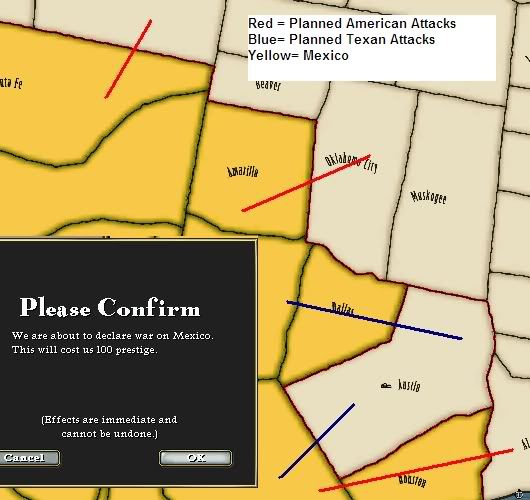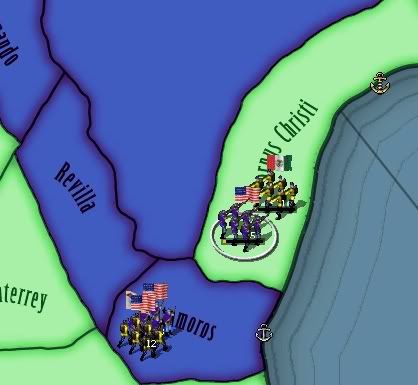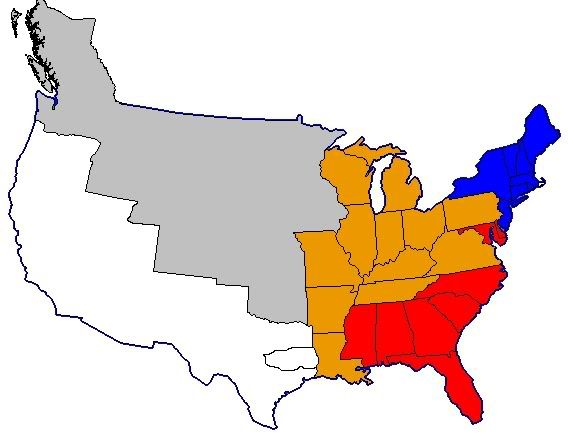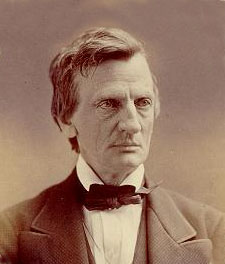~~
Manifest Destiny and the Election of 1854
--
As Colonel Patterson marched his army east from California to cut off the Baja Peninsula and drive into central Mexico; the Mexicans slowly halted their advance. Texas was too wide and to full of antagonists for the Mexican army to find success. Only General Alphonso Canedo (Brother to the failed Admiral) found success. Canedo swept into South Texas and seized the town of Corpus Christi, trapping Douglas Farr in the nearby town of Kingsville. Farr had been transferred south to hold the coast, but with the fierce fighting further north, Farr was given only a remnant of an army. Thus trapped, he had no choice but to fight his way out.
Canedo was caught unprepared as Farr exited his small fort and drove his army North-East, hoping to reach the shore and contact the fleet. Under heavy artillery fire and dangerous weather, Farr led his bold charge. At the head of 16 thousand men, Farr blitzed through the Mexican lines and drove towards the coast. He managed to drive the Mexicans out of Corpus Christi and send word to the Navy. However, the tides denied naval access to the town and its fort. Thus, Farr had traded one prison for another. The Mexicans surrounded the town, and this time there was to be no escape. Farr was killed in the first moments of the assault, as he led a counter charge with his cavalry. The daring Virginian was but the first of thousands, as all the US troops were killed by the Mexicans once the fort was taken.
Defeat in Texas
It was a galvanizing defeat. Pictures of General Douglas Farr sprouted all over the US. Suddenly, Farr, Texas and Kingsville became American Party rallying cries. Whenever President Conrad would give a speech, he would end with a call to “Remember Farr, Remember Kingsville!” It was a massacre that sparked a new furor of anti-Mexican feelings. The American Party was proud to remind people that these Mexicans were Catholics, and rebels and traitors. They were trying to inflict the Pope on America, or so many American Party loyalists said. The United States wanted vengeance.
General Burnsides and the newly appointed Colonel Don Carlos Buell, took the initiative. Bolstered by 6 divisions of reserves, the two commanders devised a plan to drive the Mexicans back. Burnsides, in stark contrast to his usual caution, charged south towards the coast, all the while staying on the far bank of the Rio Grande. Perhaps under orders from General Scott, Burnsides marched without waiting for supplies or reinforcements, he knew he had to reach the coast quickly. Buell meanwhile took over command of American troops fighting near San Antonio, and successfully drove off general Almonte. With Almonte reeling, Buell drove south, his men in perfect order, to meet General Canedo on the field where Farr lay slain. Canedo, seeing this threat, turned to flee, but was trapped by Burnsides on the far bank. Surrendering his army, Canedo left the field in disgrace. Only General Joseph Morales stood to fight the Americans, and was summarily destroyed.
Texas turns
It is at this point that the Election of 1854 should be examined. As 53 gave way to 54, the American Party was reeling. Few domestic changes had been made, and all the energy and focus of the nation was being expelled in a fruitless war in the South. Charles Magill Conrad, how had ridden disunion into power, was now faced with some of his own. Many within the party wondered aloud of Conrad was worthy of his position. This changed when he took the death of Farr in stride. The constant questions and ripping editorials turned into praise for his determination to defeat the vile enemy of the South and liberate the lands that are rightfully American.
The Whigs were all but destroyed. Only in New England did they exist in any good number. In Virginia and the South they had been driven into the waiting hands of the Democrats, with some rare exceptions. In the West they had taken to a new party, born in opposition to the American Party’s racial and economic policies. These ‘Republicans’ took hold of many lower elections in the Ohio Valley states. Therefore it was not surprising that Daniel Webster, the aged Whig politician, was able to garner a lot of support. The failed experiment of Josiah Quincy Jr was cast aside in favor of a traditional politician. Webster was able to court one of the last true Southern Whigs, William Alexander Bell (who had run against Quincy) to act as his running mate.
Benjamin Fitzpatrick
The Democrats still sat staunchly in the South. Many Old Southerners felt betrayed by the swing of Missouri, Arkansas, Tennessee and Louisiana to the American Party. These new Southerners had defeated the Democrats in 1850, and now the Democrats wanted to return the favor. So, to achieve that end, they chose a staunch Democratic candidate. Benjamin Fitzpatrick, of Alabama, carried the nomination over the head of John Tyler. For his Vice President he selected a dark horse candidate, William Dunn Moseley, the first governor of Florida, was chosen as his running mate.
The Republicans, being a so newly minted party, decided against running a candidate for fear that a loss would stain their party. They did run many gubernatorial candidates in the West and Tennessee. Instead they held back their support for a President, hoping to influence the election in the way they saw fit. This plan backfired with the death of Douglas Farr and the loss of Corpus Christi. Thousands of former Whigs were outraged over what they saw as a massacre. Suddenly it was the duty of American to win this war, despite politics. So, thanks to the lack of action on the part of the Republicans, the Mid-West went American once again. The true coup came in Virginia, where Douglas Farr became a hero. The Cavalier was a Virginia Military Institute graduate who became a symbol of the struggle. Suddenly the plantation owners found themselves out muscled by the regular men of Virginia. The Old Dominion was dangerously close to going for Conrad.
Daniel Webster and William Alexander Bell- 85
Benjamin Fitzpatrick and William Dunn Moseley- 57
Charles M. Conrad and Martin Hienz- 143











